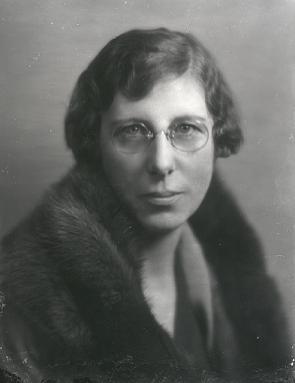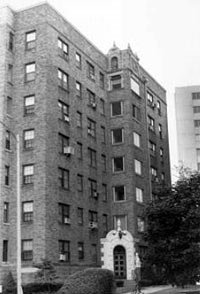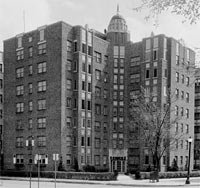On December 11, 1884, Nelle Nichols Peters was born to a farming family in Niagara, North Dakota. She would become one of the most prolific architects in Kansas City during the 1920s and design nearly 1,000 local buildings. Despite the fact that many of these buildings still occupy prominent locations, especially near the Country Club Plaza, Nelle Peters remains one of the more obscure figures in Kansas City history.

Born Nelle Elizabeth Nichols, she grew up on the North Dakota prairie until the Nichols family moved to Storm Lake, Iowa in 1899. There she attended Buena Vista College, where she studied mathematics and art. Combining these skills, she attained employment as a draftswoman at the Eisentraut, Colby and Pottenger architectural firm in Sioux City, Iowa. She began to learn about architectural design while earning $3 per week at the firm.
Nichols came to Kansas City in 1909 when the firm transferred her there. Few developers wanted to hire a female architect in the 1910s, but she did manage to take on some of her own architectural projects outside the firm. In these projects, she demonstrated a talent for designing apartment buildings. In 1911 she married William H. Peters, a Kansas City Terminal Railroad designer, and took the name Nelle Nichols Peters.
Nelle Peters's career blossomed after she connected with the Phillips Building Company in 1913. Charles E. Phillips, local real estate developer and owner of the company, hired Peters as architect on dozens of projects in the ensuing years. She specialized in apartment buildings and hotels, but also designed corporate offices and single-family residences.
Peters developed a reputation not just for the fact that female architects were extremely unusual, but for her talent. Her signature designs placed apartment complexes around a central courtyard. Her careful attention to detail brought her some national recognition within the architectural profession. She was capable of minimizing the total area taken up by her designs while still giving them an open feeling and functional spaces inside, especially with her usable kitchenette designs.
In 1923, Nelle and William Peters divorced, but Nelle embarked on the high-point of her career. Peters's designs were not overly ornamental, but they were both attractive and functional. Many still stand today. Among her most notable designs were the Luzier Cosmetics Building at 3216 Gillham Plaza, and the Ambassador Hotel at 3560 Broadway, which was the largest apartment-hotel in Kansas City when it was completed in 1924. Other prominent buildings that she designed included the Valentine Hotel (3724 Broadway), the Belleclair Apartments (401 E. Armour St), the Del Monte Apartments (200 W. Armour), the Melbourne Apartments (303 Brush Creek), the Robert Louis Stevenson Apartments (4804 Jefferson Street), the Mark Twain, Robert Browning, and Oliver Wendell Holmes apartments (on the Plaza), and Charles Phillips's personal home (5825 Overhill Road).
Unfortunately, the drop in apartment construction during the Great Depression and Second World War curtailed Nelle Peters's career in the 1930s and 1940s. She remained in the business, but had to work as a seamstress to augment her income. She finally retired in 1967, although by that year it appears that she had not had a contract in nearly 11 years. Little else is known of Nelle Peters, who was at once one of the most prolific architects and a very obscure figure in Kansas City history. When she died on October 7, 1974, at the age of 90, virtually no one acknowledged the significance of her accomplishments. While Nelle Peters herself remains largely invisible, many of the buildings she designed still contribute to the beauty of the city's landscape.
Read a full biographical sketch of Nelle Peters, prepared for the Missouri Valley Special Collections, the Kansas City Public Library:
- Biography of Nelle Nichols Peters (1884-1974), architect, by Susan Jezak Ford.
View images relating to Nelle Peters that are a part of the Missouri Valley Special Collections:
- Photograph of Nelle E. Peters.
- Postcard of The Ambassador Hotel at 36th and Broadway; with an accompanying historical article; one of four hotels by Peters’s design that was built in 1925.
- Robert Louis Stevenson Apartments at 4804 Jefferson; designed by Peters.
- Mark Twain Apartments; designed by Peters.
- Robert Browning Apartments; designed by Peters.
Check out the following books, articles, and films about Nelle Peters, held by the Kansas City Public Library:
- Kansas City, Missouri: An Architectural History, 1826-1976, by George Ehrlich.
- Kansas City Women of Independent Minds, by Jane Fifield Flynn; contains a photograph and brief biography of Peters, pp. 117-118.
- Show Me Missouri Women: Selected Biographies, edited by Mary K. Dains; contains a short biography of Nelle Peters, pp. 81-82.
- Dictionary of Missouri Biography, by Lawrence O. Christensen; contains a short biographical article about Nelle Peters, pp. 611-612.
- "Uniquely Kansas City: A History of the Arts, Part 1, The Art of the City: Making a City Beautiful," VHS documentary, Kansas City, MO: Kansas City Public Television, 2000; Peters is one of the architects that is discussed in this documentary.
- "The Architectural Career of Nelle Peters," by Sherry Piland and George Ehrich, in The Missouri Historical Review, January 1989.
- "Woman Power," by Lisa Gutierrez, in the Kansas City Star, March 16, 2007; lists and briefly describes 48 women who have contributed to Kansas City's history, including Nelle Peters.
Continue researching Nelle Peters using archival materials from the Missouri Valley Special Collections:
- Vertical File: Peters, Nelle E..
- Vertical File: Hotels - Nomination form for Valentine Hotel, 3724 Broadway, to the National Register of Historic Places; the hotel was designed by Peters.
- Vertical File: Streets - Armour Boulevard - Nomination form for the National Register of Historic Places for Armour Boulevard; two apartment buildings on the block were designed by peters.
- The Book of the Republican National Convention, Kansas City, MO, June 12, 1928; contains an advertisement for Nelle Peters’s independent architectural firm.
- Vertical File: Historic Districts--Ambassador Hotel.
References:
Upjohn Blount, "Robert Louis Stevenson Historic Plaza Living at an Affordable Price," Kansas City Star, June 9, 2007.
Mary K. Dains, editor, Show Me Missouri Women: Selected Biographies (Kirksville, MO: Thomas Jefferson University Press, 1989), 81-82.
Jane Fifield Flynn, Kansas City Women of Independent Minds (Kansas City, MO: Fifield Publishing, 1992), 117-118.
Susan Jezak Ford, "Biography of Nelle Nichols Peters (1884-1974)," the Missouri Valley Special Collections, the Kansas City Public Library, 1999.
Sherry Piland and George Ehrich, "The Architectural Career of Nelle Peters," Missouri Historical Review 83, no. 2 (January 1989): 161-176.




